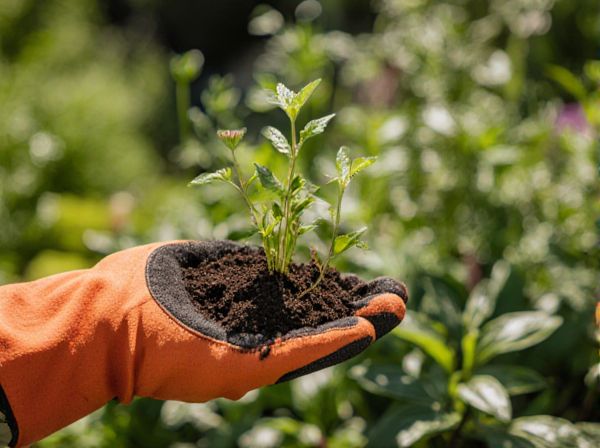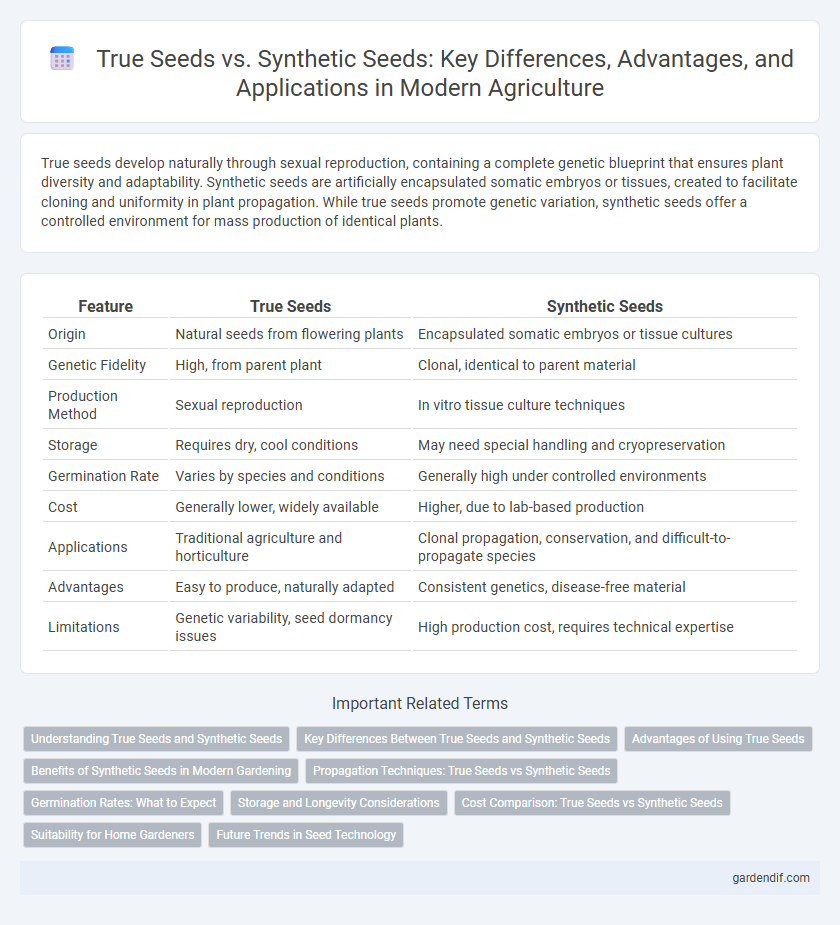
True seeds vs Synthetic seeds Illustration
True seeds develop naturally through sexual reproduction, containing a complete genetic blueprint that ensures plant diversity and adaptability. Synthetic seeds are artificially encapsulated somatic embryos or tissues, created to facilitate cloning and uniformity in plant propagation. While true seeds promote genetic variation, synthetic seeds offer a controlled environment for mass production of identical plants.
Table of Comparison
| Feature | True Seeds | Synthetic Seeds |
|---|---|---|
| Origin | Natural seeds from flowering plants | Encapsulated somatic embryos or tissue cultures |
| Genetic Fidelity | High, from parent plant | Clonal, identical to parent material |
| Production Method | Sexual reproduction | In vitro tissue culture techniques |
| Storage | Requires dry, cool conditions | May need special handling and cryopreservation |
| Germination Rate | Varies by species and conditions | Generally high under controlled environments |
| Cost | Generally lower, widely available | Higher, due to lab-based production |
| Applications | Traditional agriculture and horticulture | Clonal propagation, conservation, and difficult-to-propagate species |
| Advantages | Easy to produce, naturally adapted | Consistent genetics, disease-free material |
| Limitations | Genetic variability, seed dormancy issues | High production cost, requires technical expertise |
Understanding True Seeds and Synthetic Seeds
True seeds originate from natural fertilization processes, containing genetic material that ensures plant traits are faithfully inherited, leading to consistent growth and yield. Synthetic seeds are artificially encapsulated somatic embryos or tissue cultures designed for propagation, enabling mass production of uniform plants without sexual reproduction. Understanding the genetic stability and application methods of both true and synthetic seeds is crucial for optimizing crop production and preserving biodiversity.
Key Differences Between True Seeds and Synthetic Seeds
True seeds develop from fertilized ovules and contain a natural embryo with stored nutrients, ensuring genetic stability and viability for plant propagation. Synthetic seeds are artificially encapsulated somatic embryos or shoot buds designed for clonal propagation, lacking the natural seed coat but allowing uniformity and mass production. Unlike true seeds, synthetic seeds can bypass seed dormancy and often require controlled conditions for germination and growth.
Advantages of Using True Seeds
True seeds offer genetic stability and ensure the propagation of plants with consistent traits, making them ideal for maintaining crop quality. They support natural plant reproduction processes and typically have higher germination rates compared to synthetic seeds. Furthermore, true seeds are more cost-effective and accessible for traditional farming practices, promoting biodiversity and sustainability.
Benefits of Synthetic Seeds in Modern Gardening
Synthetic seeds offer enhanced germination rates and uniformity compared to true seeds, making them ideal for large-scale, controlled propagation. Their ability to preserve genetic material and enable storage under varied conditions supports year-round cultivation and biodiversity conservation. These seeds also facilitate rapid multiplication of rare or endangered plant species, boosting efficiency in modern gardening and horticulture.
Propagation Techniques: True Seeds vs Synthetic Seeds
True seeds propagate through natural sexual reproduction, ensuring genetic diversity and adaptability within plant populations, while synthetic seeds involve encapsulating somatic embryos or shoot buds to enable clonal propagation of genetically identical plants. True seeds require conditions for germination such as moisture, temperature, and light, whereas synthetic seeds can be stored and handled under controlled environments, improving propagation efficiency for difficult-to-grow species. Propagation techniques for synthetic seeds often include in vitro culture systems, enhancing mass production and disease-free planting material compared to traditional seed sowing methods.
Germination Rates: What to Expect
True seeds generally exhibit higher germination rates, often reaching 80-95%, due to their natural embryo development and stored nutrients. Synthetic seeds, created by encapsulating somatic embryos or tissue cultures, tend to have more variable germination rates, typically ranging between 40-70%, depending on encapsulation techniques and storage conditions. Understanding these differences helps optimize planting strategies for improved crop establishment.
Storage and Longevity Considerations
True seeds have naturally evolved protective coatings and desiccation tolerance, enabling them to remain viable for extended periods under optimal storage conditions such as low humidity and cool temperatures. Synthetic seeds, which are artificially encapsulated somatic embryos or shoot buds, typically exhibit shorter shelf life due to their higher moisture content and sensitivity to desiccation and temperature fluctuations. Proper cryopreservation and controlled environment storage are essential for enhancing the longevity of synthetic seeds, whereas true seeds generally require less stringent conditions for long-term viability.
Cost Comparison: True Seeds vs Synthetic Seeds
True seeds generally incur lower production and handling costs due to natural propagation and established agricultural practices. Synthetic seeds, while offering advantages in uniformity and disease resistance, involve higher expenses in laboratory techniques and specialized storage conditions. Cost comparison often favors true seeds for traditional farming, whereas synthetic seeds may justify higher costs in controlled environments or high-value crops.
Suitability for Home Gardeners
True seeds offer home gardeners reliable genetic traits and higher germination rates, making them ideal for consistent crop growth and preserving plant varieties. Synthetic seeds provide an alternative by encapsulating somatic embryos, allowing propagation of plants that are difficult to grow from true seeds but may have variable success rates in home conditions. Home gardeners often prefer true seeds for ease of use and predictable results in small-scale cultivation.
Future Trends in Seed Technology
Advancements in seed technology are accelerating the development of synthetic seeds, enabling precise genetic engineering and enhanced crop resilience. True seeds continue to dominate traditional agriculture due to their natural genetic diversity and adaptability. Future trends indicate a hybrid approach combining true seed preservation techniques with synthetic seed innovations to boost food security and sustainable farming practices.
True seeds vs Synthetic seeds Infographic

 gardendif.com
gardendif.com